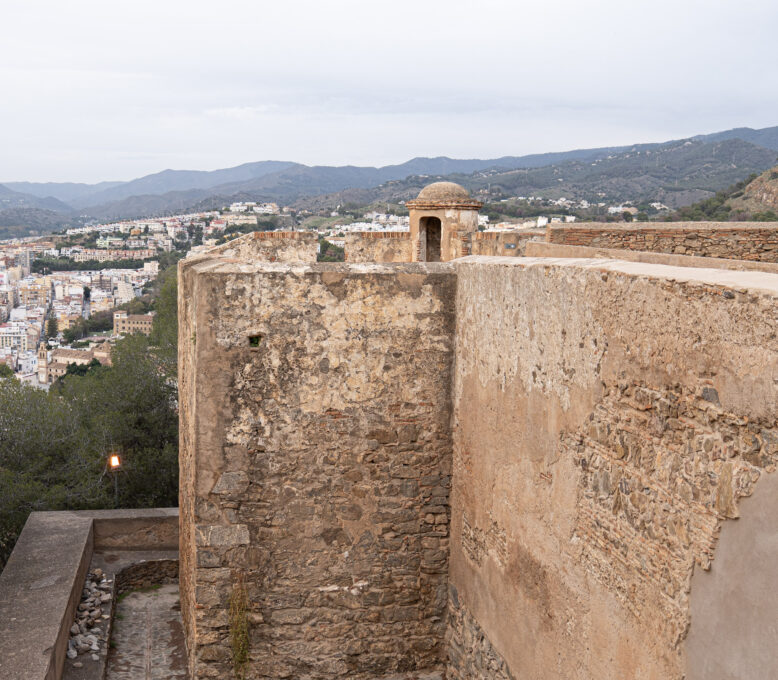History of the Gibralfaro Castle in Malaga

The fortress of Gibralfaro is one of the symbols of Málaga. It is located on the crest of the mountain of the same name, crowning it from end to end, 132 meters above sea level. At its feet, steep slopes descend toward the sea and the city. Since the beginning of Málaga’s history, this site has been essential for the different civilizations that settled here, serving as a strategic point for observing the population, guiding ships, and monitoring access to the city by land and sea.
Origins and Etymolog
This hill gets its name from the toponym (Yabal, in Arabic, “mountain,” and Faruh, from the Greek Pharos, “lighthouse”). According to tradition, a lighthouse was built here in Phoenician times to aid coastal navigation, although no remains have been found. As for establishing a fortress, we must look back to the 14th century. Between 1344 and 1354, Yusuf I ordered the construction of this castle to protect the Alcazaba below and to house the army, thus completing the most impregnable fortress of all Al-Andalus.
Architecture and Features
The fortified complex—made up of the Alcazaba, the Coracha, and Gibralfaro—formed a true defensive wall around Málaga.
- Total area: 21,310 m² (including the Coracha and the Barbican).
- Walls: 1,310 meters in perimeter.
- Inner enclosure: 12,630 m² enclosed by 733 meters of wall, with 30 sections and 8 towers, most of them solid.
The Alcazaba-Coracha-Gibralfaro complex had a strategic position, not only for visually controlling the entire area from its height but also because from far away one could see the gigantic, inaccessible fortification protecting the city and its bay. At that time, the mountain slopes were kept free of vegetation to prevent ambushes, and the sea reached almost to its base.
To make conquering Gibralfaro Castle difficult, only one entrance was established, through a monumental gate accessed via the Coracha. This led to the barbican surrounding the entire outer perimeter. The gate followed the typical “elbowed” layout, built into a large tower protected by a double door that cut across the barbican, forming a small inner courtyard with space for the guard post. Today, access is through one of the four gates opened in the walls during Christian times to facilitate the entry of supplies or military equipment.

Historical Role of Gibralfaro Castle
During the conquest of Málaga, Ahmed el Zeqrí and a contingent of Gomeres (Volunteers of the Faith) took refuge in the fortress to resist surrendering to the Catholic Monarchs. They relied on its powerful defensive system, its steady water supply from numerous wells, and the stored provisions inside.
When the city fell to the Christians, all the walls and towers, including the barbican, were restored, which is why they remain in excellent condition today. Such was its strategic importance that Isabella and Ferdinand imposed a tithe on lime, tiles, and bricks for the repair and preservation of the city’s fortifications.
In later centuries, the castle remained significant:
Later, it lost military value and was used as a prison.
War of Independence (1812): The French, upon retreating, blew up several towers and defenses.
Recovery and Restoration
In 1938, the slopes were replanted with vegetation to prevent landslides. Later, between 1989 and 1999, Málaga’s City Council and the Andalusian Regional Government carried out a comprehensive restoration of walls, towers, paths, restrooms, and entrances, preparing the castle for tourism.




Gibralfaro Castle Today
During the War of Independence, Gibralfaro underwent major fortifications and witnessed several events. From 1812 onward, under heavy pressure from Spanish troops and guerrillas, the French began retreating from Andalusia. In Málaga, they destroyed all fortifications they had built at Gibralfaro. As the last French troops abandoned the city, mines set in the castle blew up the New Tower, the outer defenses, the barracks, the breakwater battery, and the gunpowder store.
From then on, the castle lost defensive value and was used only as a military prison.
In 1938, a major reforestation project covered the mountain slopes to prevent landslides caused by heavy rains. In 1977, the military buildings were demolished and the gardens prepared for tourist visits, although the project was not completed. Later, between 1989 and 1999, the City Council and Andalusian Government restored walls, towers, paths, restrooms, parking areas, and more, making it accessible as we know it today.
Tips for Visiting Gibralfaro Castle
- The uphill walk is demanding but worth it, especially at sunset.
- You can also arrive by city bus or car (there is parking next to the castle).
- Combine the visit with the Alcazaba and the Roman Theatre at the foot of the hill.
Conclusion
Gibralfaro Castle is one of Málaga’s great symbols and a witness to its history, from its Muslim origins in the 14th century to its defensive role in later centuries. Today, restored and open to the public, it allows visitors to walk its walls and enjoy unique views of the bay. For your visit, check ticket Gibralfaro castle and opening hours Gibralfaro Castle, and experience firsthand the union of heritage, culture, and history that Gibralfaro Castle represents.


